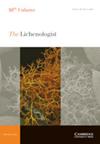Towards a nomenclatural clarification of the Peltigera ponojensis/monticola clade including metagenomic sequencing of type material and the introduction of P. globulata Miadl. & Magain sp. nov.
IF 1.4
4区 生物学
Q4 MYCOLOGY
引用次数: 0
Abstract
Abstract Peltigera globulata Miadl. & Magain, a new species in the P. ponojensis/monticola species complex of section Peltigera , is formally described. This clade was previously given the interim designation Peltigera sp. 17. It is found in sun-exposed and xeric habitats at high altitudes in Peru and Ecuador. Peltigera globulata can be easily recognized by its irregularly globulated margins covered mostly by thick, white pruina, somewhat resembling the sorediate thallus margins of P. soredians , another South American species from section Peltigera . The hypervariable region of ITS1 (ITS1-HR), which is in general highly variable among species of section Peltigera , does not have diagnostic value for species identification within the P. ponojensis/monticola complex. Nevertheless, no significant level of gene flow was detected among eight lineages representing a clade of putative species (including P. globulata ) within this complex. ITS sequences from the holotype specimens of P. monticola Vitik. (collected in 1979) and P. soredians Vitik. (collected in 1981) and lectotype specimens of P. antarctica C. W. Dodge (collected in 1941) and P. aubertii C. W. Dodge (collected in 1952) were successfully obtained through Sanger and Illumina metagenomic sequencing. BLAST results of these sequences revealed that the type specimen of P. monticola falls within the P. monticola/ponojensis 7 clade, which represents P. monticola s. str., and confirmed that the type specimen of P. aubertii falls within a clade identified previously as P. aubertii based on morphology. The ITS sequence from the type specimen of P. soredians , which superficially resembles P. globulata , confirms its placement in the P. rufescens clade. Finally, we discovered that the name P. antarctica was erroneously applied to a lineage in the P. ponojensis/monticola clade. The ITS sequence from the type specimen of P. antarctica represents a lineage within the P. rufescens clade, which is sister to the P. ponojensis/monticola clade.对珀诺詹氏佩蒂gera ponojensis/monticola分支的命名澄清,包括类型材料的宏基因组测序和P. globulata Miadl的引入。,11月11日
摘要:球藻(Peltigera globullata Miadl)。,正式描述了Peltigera剖面P. ponojensis/monticola种复合体中的一个新种Magain。这个分支以前被临时命名为Peltigera sp. 17。它被发现在秘鲁和厄瓜多尔高海拔的阳光照射和干燥的栖息地。globulata Peltigera可以很容易地通过其不规则的球形边缘被厚厚的白色毛覆盖而被识别,有点类似于P. soredians(来自Peltigera组的另一个南美物种)的单一菌体边缘。ITS1的高变区(ITS1- hr)在Peltigera剖面的种间通常是高度可变的,但对P. ponojensis/monticola复合体的种鉴定不具有诊断价值。然而,在这个复合体内代表一个假定物种(包括P. globulata)的分支的8个谱系中,没有检测到显著水平的基因流动。蒙地花全模标本ITS序列分析。(收集于1979年)和P. soredians Vitik。通过Sanger和Illumina元基因组测序,成功获得了p.a nantarctica C. W. Dodge(1941年)和p.a aubertii C. W. Dodge(1952年)的选型标本。这些序列的BLAST结果表明,该模式标本属于monticola/ponojensis 7进化支,代表了monticola s.s str.,并证实了该模式标本属于先前根据形态学鉴定为aubertii的进化支。P. soredians的模式标本的ITS序列,表面上类似于P. globulata,证实了它在P. rufescens分支中的位置。最后,我们发现南极支原猿这个名字被错误地用在了ponojensis/monticola分支的一个谱系上。来自南极拟南猿模式标本的ITS序列代表了P. rufescens分支中的一个谱系,它是P. ponojensis/monticola分支的姐妹。
本文章由计算机程序翻译,如有差异,请以英文原文为准。
求助全文
约1分钟内获得全文
求助全文
来源期刊

Lichenologist
生物-真菌学
CiteScore
2.90
自引率
14.30%
发文量
23
审稿时长
6.0 months
期刊介绍:
The Lichenologist is the premier scientific journal devoted exclusively to the study of lichens worldwide. As the leading forum for the dissemination of new concepts and topical reviews, The Lichenologist reaches more scientists concerned with the study of lichens and lichen symbionts than any other single journal. All aspects of lichenology are considered including systematics and phylogenetics; molecular biology; ultrastructure, anatomy and morphology; secondary chemistry, effects of pollutants and use as bioindicators; biogeography. In addition to standard length research papers, the journal also publishes Short Communications and Book Reviews. A monthly issue may occasionally be devoted to papers deriving from a symposium.
 求助内容:
求助内容: 应助结果提醒方式:
应助结果提醒方式:


